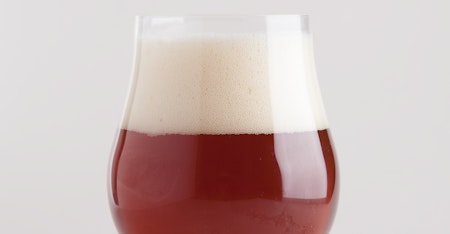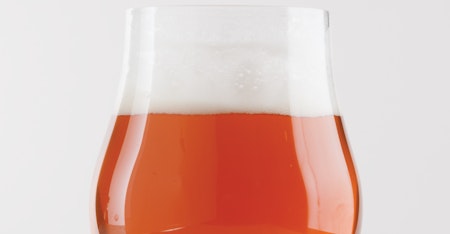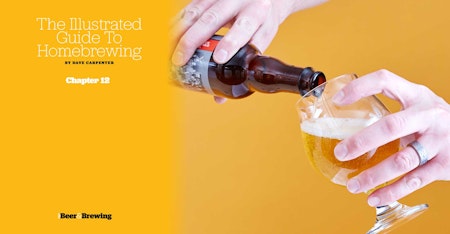Pumpkin beer predates the founding of the United States. Brewed with an indigenous fruit unknown to most Europeans until the sixteenth century, it was our first truly national beer. Its beginnings were humble—first brewed during colonial days out of necessity, when malt was scarce and fermentable sugars had to be found wherever possible. The beer became popular among colonists, either straight or mixed in a cocktail known as flip. But nothing lasts forever. Its appeal fell when nineteenth-century hipsters deemed it too rustic and quaint.
The style was resurrected more than a century later—in 1985, during the early days of the craft-beer revolution—by Bill Owens of Buffalo Bill’s Brewery in Hayward, California. Inspired by one of George Washington’s recipes, Owens brewed a pumpkin ale and added an X Factor—spices (the colonial versions were unspiced). A star was born.
Today, it seems every brewery and brewpub makes a pumpkin ale. The style has become one of America’s favorite seasonal beers. Some examples are outstanding: Southern Tier’s Pumking, Weyerbacher’s Imperial Pumpkin, and Cigar City’s Good Gourd spring to my mind immediately.
Unfortunately, there are also weak-hearted efforts. This dearth of quality has led me on a quest, now more than ten years old, to homebrew the perfect pumpkin ale. My version is robust, brims with maltiness from a solid grain bill, packs tons of pumpkin flavor, and sports an assertive spice profile. To taste my Perfect Pumpkin Ale is to savor the flavor of pumpkin pie in a glass. It’s not a difficult recipe to brew. The only special ingredient is a small investment of time.
Beer Style
Many beer styles are amenable as a base for pumpkin ale. For example, the roastiness of porter or stout makes an excellent complement to the spice regime. My recipe uses an amber ale base, which has a strong malt backbone to support the pumpkin and spices and lets the orange color shine through.
Grain Bill
The grain bill is simple. Maris Otter and Light Munich are the base malts, selected for their bready and toasty characteristics. These malts are available in extract form for those who don’t brew all-grain. The recipe is reinforced with Belgian specialty malts: Dingemans Aromatic and Caramunich for their malty aroma, hint of sweetness, and pumpkin-like orange and brown coloring.
A dose of brown sugar rounds out the recipe and adds a touch of colonial authenticity. It was a common ingredient back in the day, plus it provides additional fermentables to bump up the alcohol percentage without making the beer cloying. Over the years, I’ve brewed Perfect Pumpkin Ale at several different original gravities (sometimes unintentionally). A specific gravity of about 1.065 seems to be perfect—providing the best balance of alcohol percentage and drinkability. I mash the grains in a single step at 155°F (68°C) for 60 minutes to ensure a rich, full-bodied beer.
Pumpkin, Of Course
Pumpkin beer needs pumpkin. This revelation is lost on some brewers, for no pumpkins are harmed in the making of their beer. And while I’m on my soapbox, I prefer fresh, not canned, pumpkin. Many breweries want their pumpkin offering to be the first to hit the marketplace. Thus, the release date of a fall seasonal has become earlier and earlier (last year, the first cases of pumpkin beer appeared in retail stores at the end of June). Since the harvest has yet to occur, these early-release pumpkin ales have to be brewed with last year’s canned instead of fresh pumpkin—a violation of all that’s holy, as far as I’m concerned.
But not just any type of pumpkin will suffice. The traditional Halloween jack o’ lantern pumpkins (a cultivar of Cucurbita pepo), aren’t the best choice. They provide minimal flavor and fermentables. In my neck of the woods, I use a crookneck pumpkin (pictured at top), also known as a neck pumpkin (a cultivar of Cucurbita moschata). It’s tan in color and looks similar to a cashew on steroids. My recipe calls for about a pound of pumpkin per gallon, so buy a couple. (If you don’t have ready access to neck pumpkins, use butternut squash, also a cultivar of C. moschata.) Check the farmer’s markets first; they have better quality, prices, and selection than the supermarkets.
You need to prepare the pumpkin a few days in advance of the brew day. Using a large knife, halve the pumpkin, remove the seeds, and cut the halves into pieces about 6 inches (15 cm) long. Cover some cookie sheets with aluminum foil, arrange the pumpkin pieces on the cookie sheets, and sprinkle them liberally with brown sugar. Roast in the oven at 375°F (190°C) until soft. This usually takes two to three hours. During roasting, the brown sugar will melt and caramelize onto the pumpkin, providing extra flavor. Remove the pumpkin from the oven and let cool. Then peel off the pumpkin skin, dice the flesh into large cubes (being sure to save the juice for its color and flavor), and store in a covered bowl in the fridge. On brew day, let the pumpkin warm to room temperature and put it in the kettle for the duration of the boil. (As an aside, for those who are into sustainable brewing, the boiled pumpkin flesh makes excellent pies.) To avoid a mess in the kettle and clogged valves or siphons, put the pumpkin into either a large fine-mesh bag designed for fruit or a hop spider equipped with a paint-straining bag.
Hops and Spices
Unlike for an IPA, hops aren’t a big deal for pumpkin ale. Almost any clean-flavored hops will do. I’ve used Fuggles in the past, but now I prefer a higher alpha-acid variety—such as Northern Brewer, Galena, or Magnum—to keep the vegetal matter to a minimum. Only a bittering dose is needed, not quite 20 IBUs’ worth, to keep the malt sweetness in check.
As Buffalo Bill’s Bill Owens discovered, spices make the pumpkin ale come alive. They take the place of the traditional flavor and aroma hops. This is where you can be creative and let your imagination run wild.
My spice regimen is aggressive: lots of cinnamon, nutmeg, and ginger, and a touch of vanilla. I prefer Saigon cinnamon (Vietnamese cinnamon) to other varieties for its strong, rich, and sweet flavor. It’s more expensive than regular cinnamon, but it’s usually on sale during the holidays. I don’t care for other pumpkin-pie spices, such as cloves or allspice (although my wife always tries to sneak in some allspice when I’m not looking), so I don’t use them. But if you like a particular spice, by all means use it.
Vanilla is the key final additive. It provides a certain je ne sais quoi—a flavor that can’t be ascertained, but would be missed if not present. Vanilla lends a silky creaminess and rounds out the spice profile. I add the vanilla during the secondary conditioning phase, a few days before kegging. But be careful—while the other spice flavors will mellow and soften with age, vanilla won’t. You’re stuck with it.
The amounts of the spices in my recipe may seem daunting. Most pumpkin ale recipes call for only one or two teaspoons of spices altogether. Don’t be afraid. You have nothing to fear but bland beer. If you’re squeamish about the amounts, add the spices gradually—tasting along the way—until you achieve the flavor you want. It’s always possible to add more, but you can’t subtract once it’s in. I add my spices just before knockout and later, in the form of a hot “tea,” during conditioning, much the way you would dry hop.
Yeast
The yeast strain is important—I ferment with White labs WLP002 English Ale yeast. Fermentation takes off like gangbusters, and it flocculates beautifully a few days later, leaving a wonderful pumpkin color and just a hint of desired sweetness. I used to ferment at 65°F to 68°F (18°C to 20°C), but I’ve found that fermenting at 72°F to 74°F (22°C to 23°C) seems to give a better flavor profile—perhaps from the increased ester production.
An alternative yeast that’s worth investigating is White Labs WLP565 or Wyeast 3724 Saison Dupont. Tröegs Brewing made a wonderful pumpkin ale, Master of Pumpkins, using this strain. Whatever your choice, don’t ferment with California Ale yeast. Its clean flavor profile is outstanding for so many styles, but it doesn’t enhance pumpkin ale. In addition, it ferments too dry.
As with all my homebrews, I make a 1.5-liter starter a few days before brew day to ensure complete fermentation. Don’t let the yeast’s chunkiness scare you. Pour off most of the liquid on top before pitching—it’s not really beer.
Fermentation
Even though primary fermentation will be complete in a few days, wait at least a week before racking to a secondary fermentor. The secondary phase lasts another week or two. At this juncture, taste and add more spices as needed. The spice profile may seem a little rough at this point, but don’t panic. All the flavors will magically coalesce—snap together. Add the vanilla a few days before bottling or kegging.
Sometimes, the waiting is the hardest part, but your patience will be rewarded. My Perfect Pumpkin Ale recipe takes about a month of conditioning to hit its peak, which it will retain throughout the winter and well into the spring—although your first Perfect Pumpkin Ale probably won’t last that long. Cheers!
Fresh is Best
My mind is boggled by brewers—obsessively quality-conscious folk—who commit hours of work to brewing and then ruin their masterpieces by adding dollar-store quality spices. We wouldn’t settle for anything but the best with our malts, extracts, and hops. The good stuff—gourmet cinnamon, freshly ground nutmeg and ginger—costs a mere pittance more, but the flavor blows away the cheap stuff. Often, these ingredients are on sale during the holidays.
And don’t skimp on the vanilla, either. Imitation vanilla is vile and can’t compare to pure vanilla extract, which has myriad other uses, not the least of which is holiday baking. While many of these spices are available at grocery stores or spice shops, I highly recommend Penzeys Spices. Their quality, prices, and customer service are outstanding.
The Eternal Question
As the Homebrew Bard once opined: To mash or boil? That is the question. When my Perfect Pumpkin Ale recipe was first published, one would have thought I was guilty of heresy for boiling the pumpkin in the wort instead of mashing. I’d never seen so much such vitriol before in homebrewing forums: It’ll be filled with starch—undrinkable, cloudy, and unstable!
That’s nonsense—an old brewer’s myth, like the existence of hot-side aeration. The starches in the raw pumpkin seem to convert during the oven-roasting process, the ale is crystal clear, and the stability improves with age—the pumpkin ale I brew in the fall is still delicious the next summer.
I believe in freedom of choice. If you want to mash your pumpkin, continue to do so. All you’ll get for it is a few gravity points and probably a stuck mash. To maximize the pumpkin flavor and get a lovely orange-colored ale in the process, take a walk on the wild side and boil your pumpkin.
PHOTO: MARK PASQUINELLI








